Morgan Rielly finally had his long-awaited breakout for the Toronto Maple Leafs last season, posting 20 goals and a whopping 72 points in 82 games. He averaged over 23 minutes per game while generally facing top opposition with partner Ron Hainsey, and no matter how you slice it, his production was elite.
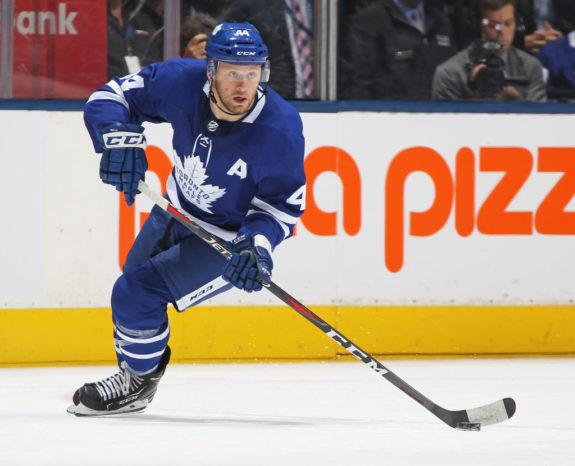
Rielly finished second among defencemen in 5v5 points-per-hour (1.72), trailing only Norris Trophy winner Mark Giordano, while finishing fourth in all strengths points-per-hour (2.28). His production was also historically good for a Maple Leafs franchise that’s been starved of elite offensive defencemen: his 72 points marked the fifth-highest scoring campaign ever, and just seven behind Ian Turnbull’s record 79 points set in 1976-77.
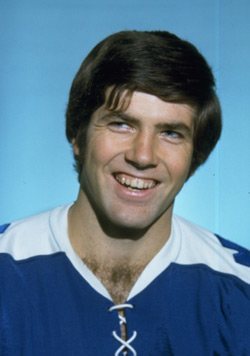
But even with his nearly record-setting production and a fifth-place finish in Norris Trophy voting, Rielly had his fair share of struggles, especially in the defensive zone. And the truth is that the 25-year old’s breakout season may have been more a result of luck than repeatable ability.
He Scored More Than He Should Have
Rielly led all defenceman in goal-scoring last season with 20. Surely there’s no fault to find in that, right?
He had a terrific season and he should be lauded for his performance, but when we dig into the numbers, it’s clear that the West Vancouver native benefited from a significant amount of puck luck.
For starters, let’s look at individual expected goals (ixG), which measure how many goals a player should have scored based on shot quality and location. According to ixG, Rielly should have scored just about 10 times. The fact that he doubled his expected goal production is already a red flag. He admittedly has a terrific wrist shot, but it’s by no means elite, especially considering that most of his shots come from the blue line.
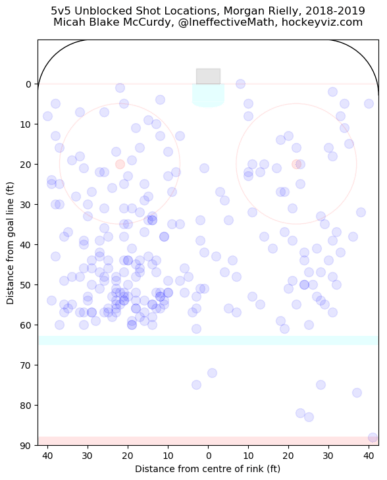
Comparing him to his peers around the league only makes Rielly’s puck luck more apparent. Among defencemen, he was far and away the leader in actual goals scored over expected goals (GoxG) with a plus-9.8 difference.
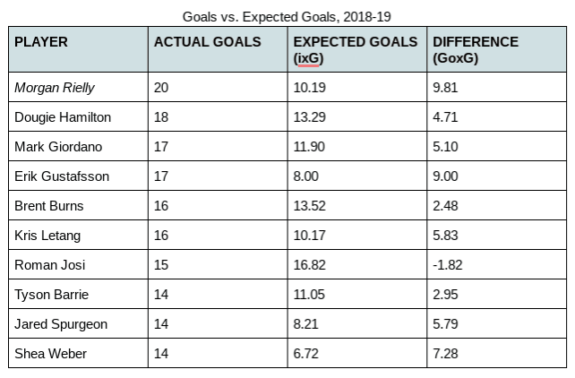
Only Erik Gustafsson and Shea Weber were really close to Rielly in terms of GoxG last season, but in their cases, the ability to score more than expected actually seems repeatable. Weber shot 8.4 percent on the season, which is right around his career rate of 8.2, while Gustafsson shot 10.6 percent, but his career mark is still respectable at 7.6.
Rielly, in comparison, has been a career 5.2 percent shooter, and if you remove this past season where he shot 9 percent, his career average actually drops all the way down to just 4. That’s worse than Rielly’s partner and noted defensive defenceman, Hainsey, who’s scored on 4.2 percent of his shots over his 16-year career.
Even if we give Rielly some leeway and say that he’s improved his shot and ability to jump up into the play, he still won’t be a consistent nine percent shooter. If he shoots somewhere between his career average and last season’s performance, that puts him at 6.5 percent. And if he can continue to be a high volume shooter (he had 223 shots last season), that helps his case. But even then, that equates to just 14 goals – a far cry from his league-leading 20.
His On-Ice Goals Were Probably Unsustainable
Just as we found that Rielly outscored his ixG, we can apply the same study to his on-ice goals (goals for and against whenever Rielly is on the ice at 5v5). And surprise, surprise: the Maple Leafs’ No. 1 defenceman heavily outscored his expected goals at the team level, too.
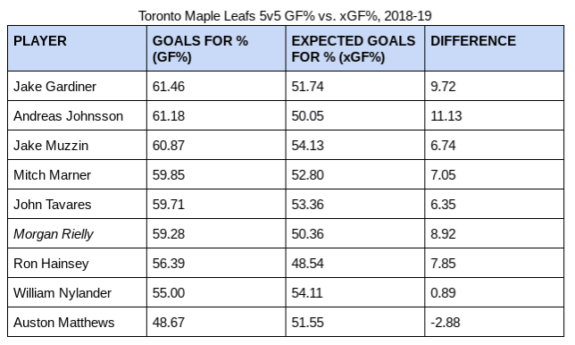
Among Maple Leaf players last season, Rielly ranked third in terms of how much he outperformed his xGF%, with a positive differential of 8.92 percent. Other than Rielly’s gaudy numbers, it should also jump out at you that almost all of the Maple Leafs’ top players significantly outperformed their xGF%. This could mean one of two things: either the team as a whole has an ability to outscore their expected results, or they collectively went on an unsustainable scoring bender. There are valid arguments to be made for both sides (they do have a plethora of elite goal scorers who generally score more than they “should”), but the truth likely lies somewhere in the middle.
The worry for Rielly, though, comes in the larger sample size. From 2015-16 to 2017-18, he did not outperform his xGF% and, in fact, he underperformed. Over those three seasons, he had a GF% of 44.79 compared to an expected mark of 49.02, giving him a differential of minus-4.23. From an objective, statistical standpoint, we generally trust the larger sample over the smaller one. In this case, we’re comparing 234 games played to just 82, and the three-year sample suggests that Rielly isn’t the on-ice goal producing juggernaut that he was this past season.
His Defensive Struggles Persisted
If you’ve followed Rielly’s career closely, you probably know that he’s a pure offensive defenceman. Despite being used in tough match-up roles over the past few seasons, he is not a defensive stalwart by any means, and any positive value he produces comes from his offensive ability.
Among defencemen, Rielly allowed the fourth-most shots against per hour (37.02) and 11th-most Corsi against per hour (64.94). Now he also balanced that out with an incredible ability to drive offence, ranking 10th and fourth in shots-for (35.23) and Corsi-for (68.69) per hour, respectively.
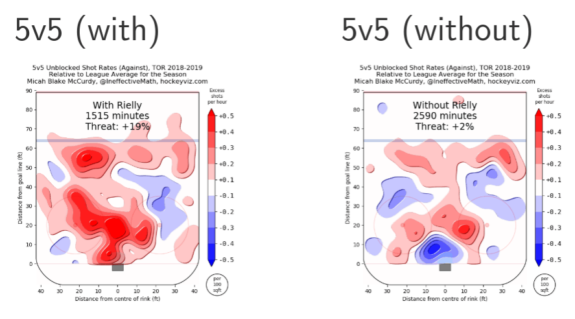
The Maple Leafs were actually about a league-average defensive team at 5v5 without Rielly, but the results shifted drastically when he took the ice. Despite all the good he does, it’s certainly worrisome when your top defenceman is also your worst defensive player.
Ultimately, the question we need to ask is what kind of player he is. Who is the real Rielly? Is he the kind of player who can consistently outperform his expected goals and outscore his defensive woes, like he did last season? Or is he going to regress to his past results, getting both outshot and outscored?
Next season might just give us some answers.
Player stats from https://www.hockey-reference.com/ and http://www.naturalstattrick.com/